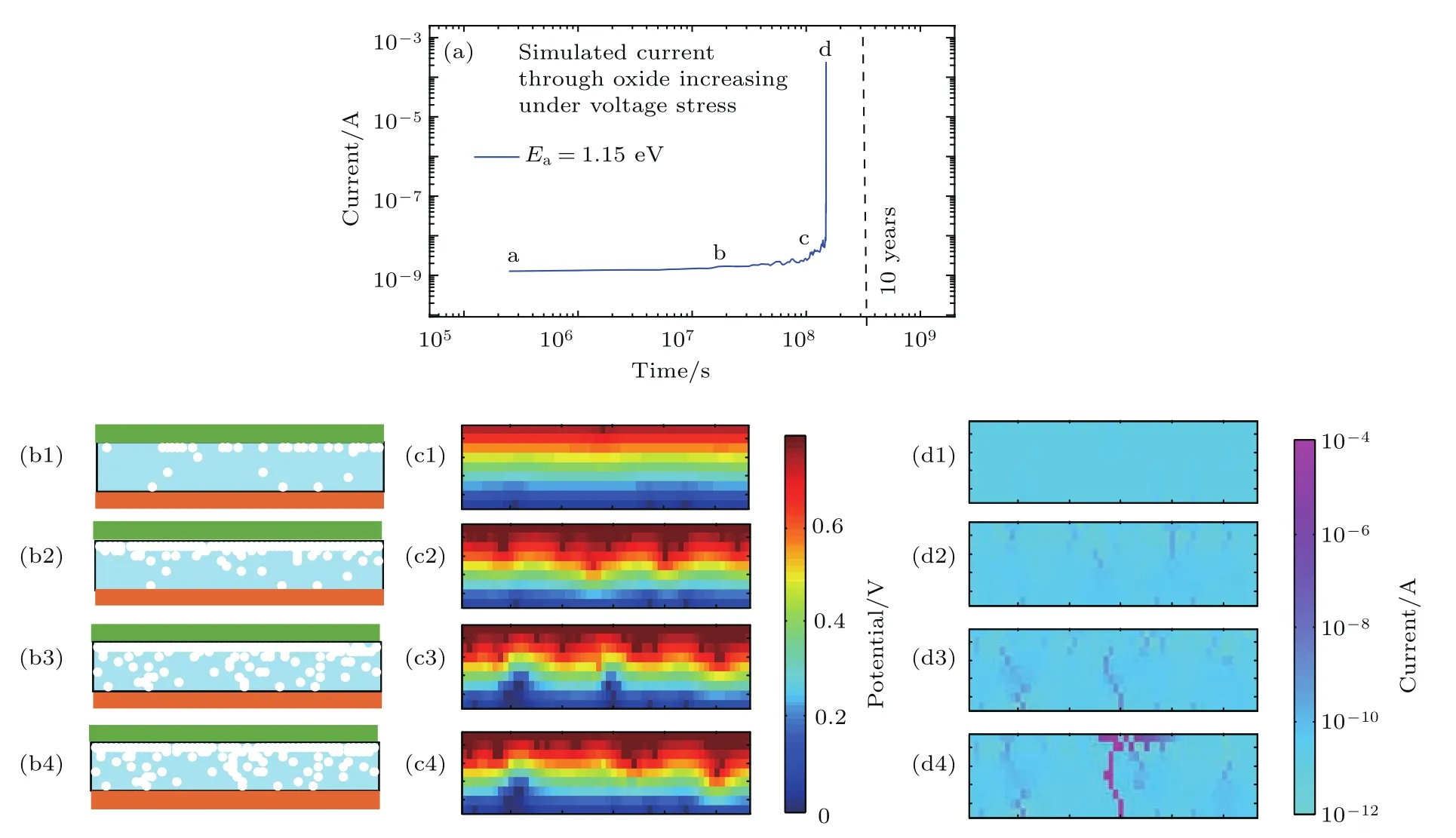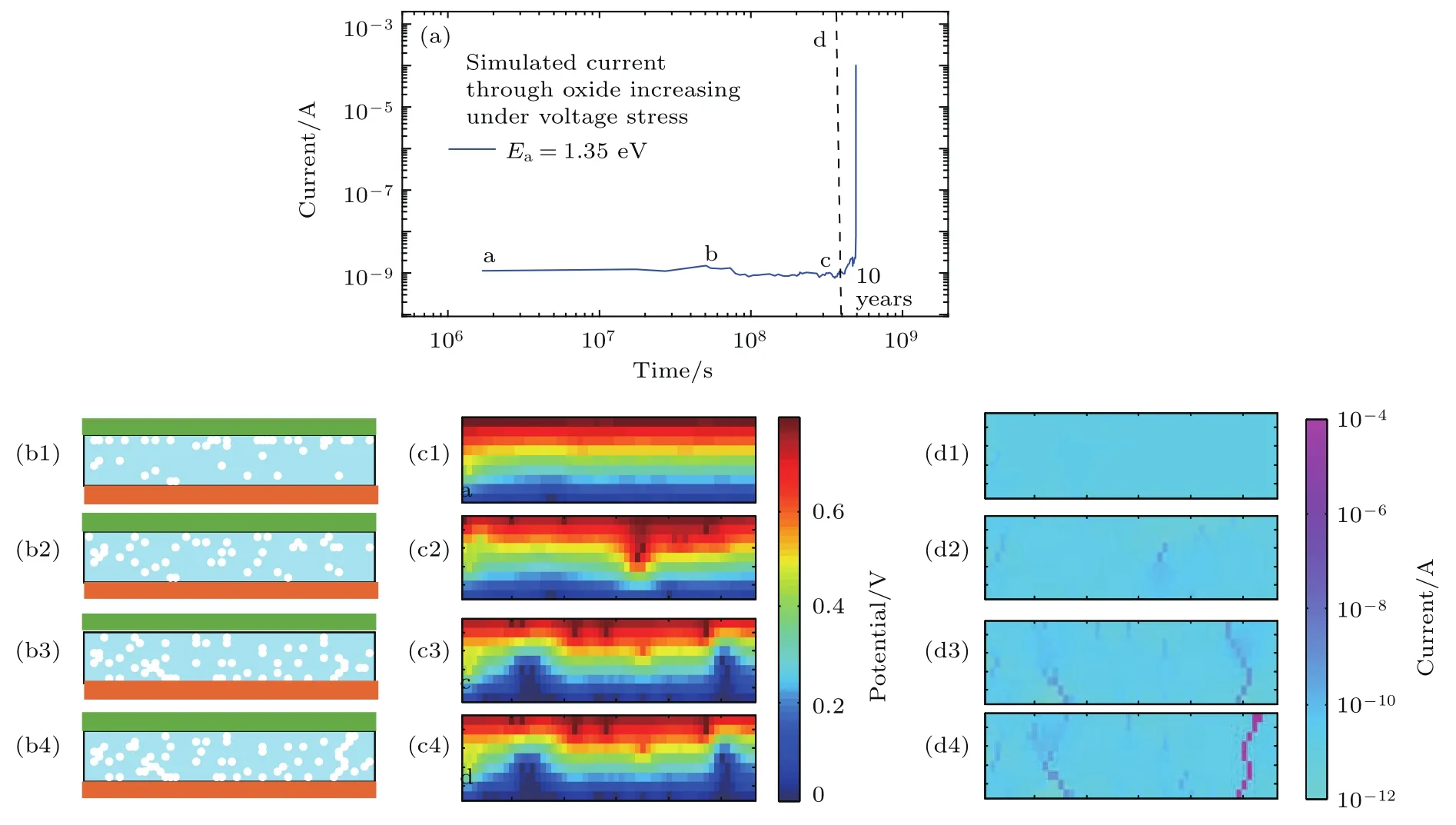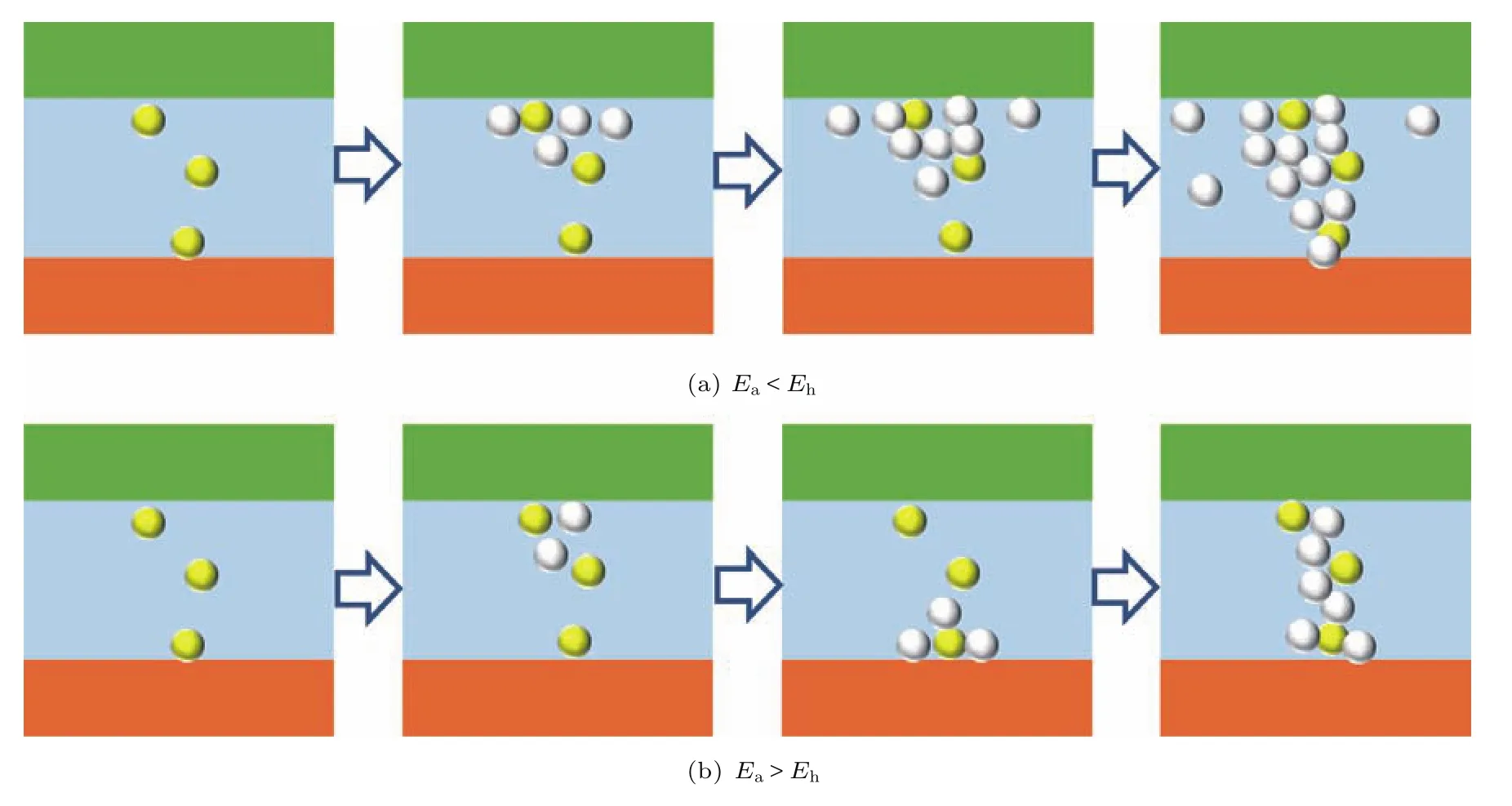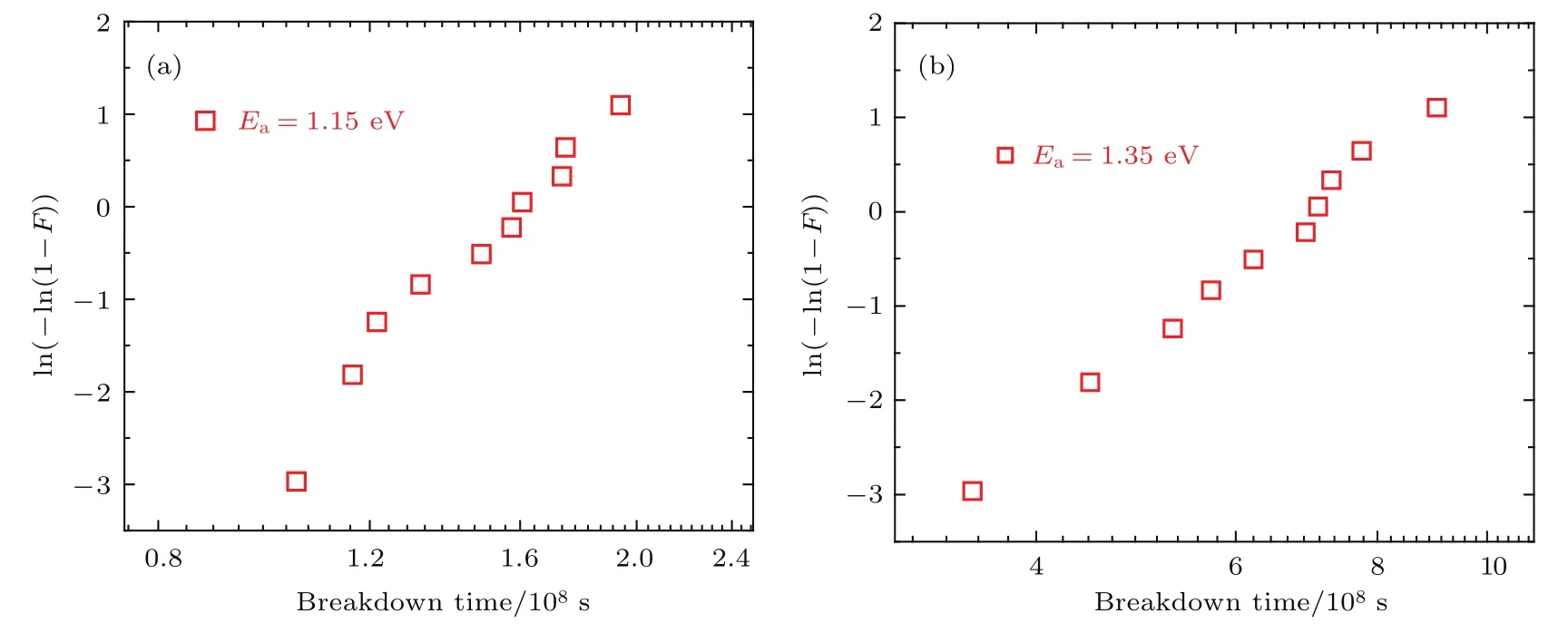氧空位迁移造成的氧化物介质层时变击穿的蒙特卡罗模拟
2017-11-10栗苹许玉堂
栗苹 许玉堂
(北京理工大学机电学院,北京 100081)
氧空位迁移造成的氧化物介质层时变击穿的蒙特卡罗模拟
栗苹 许玉堂†
(北京理工大学机电学院,北京 100081)
(2017年5月19日收到;2017年7月3日收到修改稿)
氧空位,蒙特卡罗,氧化物介质,模拟
1 引 言
半导体产业是近几十年信息技术革命的基础,其核心技术是互补金属氧化物半导体晶体管组成的集成电路.根据摩尔定律,金属氧化物半导体(MOS)晶体管尺寸不断缩小,将在10年内逼近其物理极限.其中栅介质厚度的按比例缩小是其中最先达到物理极限的部分,为了进一步缩小晶体管,现在广泛采用的方法是使用金属氧化物高κ介质层作为栅极绝缘层[1].但由于可应用于工业生产的金属氧化物高κ介质层的组分、形态及晶体结构等都十分复杂,其可靠性问题亦是实际应用的瓶颈[2].而在金属氧化物栅介质的可靠性问题中,其在电压应力作用下的时变击穿特性(time dependent dielectric breakdown)是其中的核心的问题之一[3,4].随着MOS器件按比例缩小,其工作时施加在栅介质层上的电场愈来愈强.当电场强到一定程度氧空位的形成与迁移将成为金属氧化物介质层时变击穿的主导因素.氧空位随着时间在介质层内部积累并演化形成导电通道引起介质层损伤并失效,称为氧空位迁移导致的金属氧化物介质时变击穿[5].对于较强电场下的氧空位形成与迁移引起的金属氧化物介质击穿的研究还仅仅处于起步阶段.虽然氧空位形成与迁移的微观机理已经被初步研究[6,7],但其如何具体地影响介质层击穿尚未得到深入研究.
本文基于微观机理,建立可靠的模拟工具来仿真氧空位形成与迁移引起的金属氧化物介质击穿过程,为进一步研究介质击穿机理与评估高κ栅介质的可靠性提供依据.
2 金属氧化物中氧空位形成与迁移的微观机理
如图1所示,在电场作用下金属氧化物介质内部的晶格氧有一定概率被激发形成氧空位,但其迁移功函数非常高,只有极低的概率会形成氧空位.而若其周围有氧空位存在,晶格氧不需完全克服共价键的束缚就可以迁移到近邻氧空位的位置.因此可以等效地认为是氧空位在介质层中迁移,且氧空位的存在会造成迁移势垒(迁移功函数)降低.此外,在介质内氧空位可以越过势垒向任意近邻的含有晶格氧的位置迁移.在半导体工艺制程中,金属氧化物介质层上下两端界面一般是金属性材料或沟道材料,而这些材料都会促进氧空位在绝缘界面处的形成,其迁移功函数与界面性质相关.当施加电场时,沿电场方向的形成氧空位迁移功函数与迁移势垒会显著降低,氧空位会在电场较强处较快地形成与迁移,最终积累形成导电通道造成介质击穿.
氧空位在介质界面处的形成概率可以用(1)式来描述:

其中Pi为氧空位形成概率,ν为氧空位形成与迁移的振动频率,n为氧空位所带电荷数目,q为单位电荷量,E为局域电场,k为玻尔兹曼常数,T为环境温度,Ea为形成氧空位迁移功函数.
氧空位在介质内部的迁移概率可以用(2)式来描述:

其中Ph为氧空位迁移概率,Eh为氧空位迁移势垒.

图1 (网刊彩色)氧空位在金属氧化物中迁移的微观机理(金属氧化物介质内部氧空位的存在会造成势垒降低,在介质内氧空位可以越过势垒向任意近邻含有晶格氧的位置迁移,电场能够造成氧空位迁移势垒的变化;介质界面处会有氧空位形成,其迁移功函数受电场调控)Fig.1.(color online)The microscopic mechanism of the migration of oxygen vacancies in metal oxides.The presence of oxygen vacancies in the metal oxide dielectric can cause a reduction in barrier,the oxygen vacancies can migrate over the barrier to the position of any nearest neighbor containing lattice oxygen in the medium.The electric field can cause the change of oxygen vacancy migration barrier;the oxygen vacancies are formed at the interface of the dielectric,and the transfer work function is controlled by the electric field.
3 模拟方法
如图2(a)所示,首先根据对称性建立二维网格来表示三维的金属氧化物介质层,本模拟中氧化层厚度设置为9个格点,从图1可得氧空位的最小迁移距离约为其晶格常数的一半,而金属氧化物的晶格常数约为0.5—0.7 nm,在本模拟中氧空位的单位迁移距离为0.25 nm(非晶态情况下,一般的氧空位的最小迁移距离小于晶格常数的1/2).因此可得本模拟中的金属氧化物介质层厚度约为2.3 nm,符合14 nm以下技术节点的MOS晶体管栅介质的物理厚度,且模拟的介质层物理宽度为14 nm.由于在金属氧化物介质层内氧空位可以越过势垒向任意近邻的含有晶格氧的位置迁移,所以如图2(a)所示,在模拟中设置氧空位可以向邻近的8个任意格点位置迁移.根据氧空位分布,可以计算介质层内部电场分布与电流,将得到的电场迭代到(1)和(2)式中计算氧空位形成与迁移概率.使用蒙特卡罗方法模拟氧空位的形成与迁移得到其新的分布[8].在本模拟中,计算电势分布、局域电场及电流是通过构建以各个格点作为节点的无源电路网络,各格点与相邻的8个格点都形成电流支路,再利用基尔霍夫定理计算得到.各点间的电流由(3)—(5)式描述.其中当两格点都被晶格氧占据时,电子有极低的概率在其间跳跃输运,

其中Δφ为格点间电势差;α,R2为表示电子跳跃输运的特征参数.
金属电极与晶格氧占据的格点或单侧被氧空位占据的格点间的输运可由(4)式表示:

由于氧空位可供电子跳跃输运的能级较多,所以比两格点都被晶格氧占据时跳跃概率要高;β为引入的特征参数.
当两格点都被氧空位占据时,电子输运为金属性,可由(5)式描述,

其中R1为格点间电阻.
具体的模拟流程及使用的关键参数在图2(b)和图2(c)中给出.

图2 (网刊彩色)(a)模拟方法示意图(根据对称性建立二维网格来表示金属氧化物介质层并通过蒙特卡罗方法计算氧空位在网格中的随机产生与迁移;同时根据氧空位分布计算电势分布与电流,进而来模拟介质层的击穿过程,其中氧空位可以向相邻的8个格点迁移且沿电场方向的迁移概率较大;介质层内部电场分布与电流通过构建各个格点作为节点的电路网络,然后利用基尔霍夫定理计算得到);(b)氧空位迁移导致的金属氧化物介质击穿的蒙特卡罗模拟流程图;(c)模拟过程使用的关键参数Fig.2.(color online)(a)Schematic diagram of simulation method:a two-dimensional grid is constructed to represent the metal oxide dielectric layer according to symmetry,and the Monte Carlo method is used to calculate the random generation and migration of oxygen vacancies in the grid;at the same time according to the oxygen vacancy,we first calculate the potential distribution and current,simulate the breakdown process of dielectric layer;the oxygen vacancies can migrate to eight adjacent grid sites,and the probability of migrate along the electric field direction is larger;we construct a circuit network in which each lattice is as a node,and then use Kirchho ff’s theorem to calculate the electric field distribution and current in the dielectric layer.(b)Flow chart of Monte Carlo simulation of metal oxide dielectric breakdown induced by oxygen vacancy migration.(c)Key parameters used in the simulation process.
4 模拟结果与讨论
通过蒙特卡罗模拟可得到界面形成氧空位迁移功函数较低(Ea=1.15 eV)时金属氧化物介质层的击穿过程.如图3(a)所示,在电压应力的作用下,通过介质层的电流将逐渐增加,最后剧烈上升造成击穿.图3(b1)—(b4)为模拟得到的图3(a)中相应时间(a,b,c,d)的氧空位在金属氧化物介质中的分布情况,首先氧空位在界面附近大量形成,然后向介质内部逐渐迁移,最后形成导电通道.图3(c1)—(c4)为模拟得到的与图3(a)和图3(b)对应的氧化物介质中的电势分布,从模拟结果可见,氧空位积累较多的区域电场较强,形成正反馈促进了导电通道的形成.图3(d1)—(d4)为模拟得到的与图3(a)、图3(b)和图3(c)对应的流经介质层内部(各格点)的电流,随着氧空位的积累,介质内部电流越来越大且越来越集中,最后模拟结果显示了清晰的导电通道.
图4为模拟得到的界面形成氧空位迁移功函数较高(Ea=1.35 eV)时,氧空位形成与迁移造成的金属氧化物介质层的击穿过程.如图4(a)所示,开始时在电压应力的作用下通过介质层的电流变化较小,然后将逐渐增加,最后剧烈上升造成击穿;图4(b1)—(b4)为模拟得到的图4(a)中相应时间(a,b,c,d)的氧空位在介质层中的分布,首先少量氧空位在界面附近形成,然后向介质内部逐渐迁移,在另一侧界面形成堆积,最后形成导电通道;图4(c1)—(c4)为模拟得到的对应的氧化物介质中的电势分布,从模拟结果同样可以发现氧空位积累较多的区域电场较强,形成正反馈促进了导电通道的形成,但其氧空位的迁移与其形成相比较快,存在显著的再分布,所以电势变化也较为随机;图4(d1)—(d4)为模拟得到的对应的流经介质层内部(各格点)的电流,随着氧空位的积累介质内部电流越来越大且分布越来越不均匀,最后形成导电通道.

图3 (网刊彩色)(a)模拟得到的金属氧化物介质层的击穿过程(Ea=1.15 eV),当施加电压应力时通过介质层的电流逐渐增大;(b1)—(b4)为模拟得到的图(a)中相应时间(a,b,c,d)的氧空位分布,白色圆点为氧空位;(c)模拟得到的介质层内部的电场分布;(d)模拟得到的流过介质层内部(各格点)的电流Fig.3.(color online)(a)The simulated breakdown process of the metal oxide dielectric layer is(Ea=1.15 eV),and when the voltage stress is applied,the current passing through the dielectric layer gradually increases;(b1)–(b4)the oxygen vacancy distribution of the corresponding time(a,b,c,d)in panel(a),and the white dots are oxygen vacancies;(c)the obtained electric field distribution inside the dielectric layer by simulation;(d)the obtained current of flow through the dielectric layer(each lattice)by simulation.

图4 (网刊彩色)(a)模拟得到的金属氧化物介质层的击穿过程(Ea=1.35 eV),当施加电压应力时,通过介质层的电流逐渐增大;(b1)—(b4)为模拟得到的图(a)中相应时间(a,b,c,d)的氧空位分布,白色圆点为氧空位;(c)模拟得到的介质层内部的电场分布;(d)模拟得到的流过介质层内部(各格点)的电流Fig.4.(color online)(a)The simulated breakdown process of the metal oxide dielectric layer(Ea=1.35 eV),and when the voltage stress is applied,the current passing through the dielectric layer gradually increases;(b1)–(b4)the oxygen vacancy distribution of the corresponding time(a,b,c,d)in panel(a),and the white dots are oxygen vacancies;(c)the obtained electric field distribution inside the dielectric layer by simulation;(d)the obtained current of flow through the dielectric layer(each lattice)by simulation.

图5 (网刊彩色)氧空位迁移导致的金属氧化物介质层的击穿过程的示意图 (a)界面氧空位迁移功函数小于其迁移势垒;(b)界面形成氧空位迁移功函数大于其迁移势垒Fig.5.(color online)Schematic diagram of the breakdown process of metal oxide dielectric layer induced by oxygen vacancy migration:(a)The migration function of the oxygen vacancy at interface is smaller than its migration barrier;(b)the migration function of the oxygen vacancy at interface is larger than its migration barrier.

图6 (网刊彩色)蒙特卡罗模拟得到的氧空位迁移导致的金属氧化物介质层的时变击穿过程的韦伯分布 (a)界面形成氧空位迁移功函数为1.15 eV;(b)界面形成氧空位迁移功函数为1.35 eVFig.6.(color online)The Weber distribution of time dependent dielectric breakdown process of the metal oxide dielectric layer caused by the oxygen vacancy migration,which is obtained by Monte Carlo simulation:(a)The migration work function of formed oxygen of the interface is 1.15 eV;(b)the migration work function of formed oxygen of the interface is 1.35 eV.
通过图3与图4的对比可以发现,在界面形成氧空位迁移功函数不同时,金属氧化物介质层击穿过程不同(导电通道演化过程不同).图5显示了界面形成氧空位迁移功函数分别大于和小于其迁移势垒时的介质击穿过程.当迁移功函数较小时,氧空位在其形成界面大量堆积,并从界面向介质内部迁移形成导电通道,击穿时间由氧空位在介质中的迁移势垒决定.而当氧空位在界面迁移功函数较大时,形成的氧空位快速迁移到另一侧界面,导电通道反向生长造成介质击穿,因此当氧空位在界面迁移功函数较大时,优化界面可以有效提高其可靠性.此外介质内部的原生缺陷对氧空位的迁移有重要影响,击穿往往在原生缺陷较多的位置发生.
通过蒙特卡罗方法可以模拟得到服从韦伯分布(Weibull distribution)的金属氧化物介质击穿时间统计,如图6所示.在准确提取材料参数的情况下,建立的模拟工具可以有效地帮助评估金属氧化物介质的可靠性.此外,模拟显示优化界面提高形成氧空位迁移功函数,可以有效增加击穿时间,提高栅介质可靠性.
5 结 论
通过施加电场能够降低金属氧化物内部沿电场方向的氧空位迁移势垒和迁移功函数,利用蒙特卡罗方法计算氧空位的随机形成与迁移可模拟介质时变击穿.利用建立的模拟工具发现界面形成氧空位迁移功函数对介质层击穿行为有重要影响,优化界面提高迁移功函数可显著提高介质可靠性.此模拟工具可应用于MOS晶体管栅介质击穿研究并准确评估其可靠性.
[1]Mark T B,Robert S C,Tahir G,Kaizad M 2007IEEE Spectrum44 29
[2]Ribes G,Mitard J,Denais M,Bruyere S,Monsieur F,Parthasarathy C,Vincent E,Ghibaudo G 2005IEEE Trans.Dev.Mater.Reliab.5 5
[3]Liu H X,Fang J P,Hao Y 2001Acta Phys.Sin.50 1172(in Chinese)[刘红侠,方建平,郝跃 2001物理学报50 1172]
[4]Ma Z F,Zhuang Y Q,Du L,Bao J L,Li W H 2003Acta Phys.Sin.52 2046(in Chinese)[马仲发,庄奕琪,杜磊,包军林,李伟华2003物理学报52 2046]
[5]Ranjan A,Raghavan N,Shubhakar K,Thamankal R,Molina J,O’Shea S J,Bosman M,Pey K L 20162016 IEEE International Reliability Physics SymposiumPasadena,USA,April 17–21,2016 p7A-4-1
[6]Yang C H,Chen S C,Tsai Y S,Lu R,Lee Y H 20162016 IEEE International Reliability Physics SymposiumPasadena,USA,April 17–21,2016 p7A-1-1
[7]Park S G,Magyari-Köpe B,Nishi Y 2011IEEE Electron Dev.Lett.32 197
[8]Huang P,Gao B,Chen B,Zhang F F,Liu L F,Du G,Kang J F,Liu X Y 2012SISPAD 2012Denver,USA,September 5–7,2012 p312
PACS:77.84.Bw,77.22.–d,85.30.–z DOI:10.7498/aps.66.217701
†Corresponding author.E-mail:xytang@foxmail.com
Monte Carlo simulation of time-dependent dielectric breakdown of oxide caused by migration of oxygen vacancies
Li Ping Xu Yu-Tang†
(Mechanical and Electrical College,Beijing Institute of Technology,Beijing 100081,China)
d 19 May 2017;revised manuscript
3 July 2017)
In this article,the Monte Carlo method is used to study the formation and migration of oxygen vacancies in metal oxide dielectric.The time-dependent breakdown of the dielectric is simulated.In the direction of the electric field across the metal oxide,the migration barrier and migration work function of oxygen vacancies are found to be reduced by the applied electric field.This finding provides a good foundation for further studying the breakdown mechanism and evaluating the reliability of highκgate dielectric.The Monte Carlo process is described as follows.Firstly,a three-dimensional metal oxide dielectric layer is built with two-dimensional symmetrical grid,where the thickness of the oxide layer is set to be 9 lattice points and the oxygen vacancies can migrate to the adjacent 8 arbitrary lattice positions in this simulation.Secondly,the possibilities of formation and migration of oxygen vacancies are calculated according to the distribution of oxygen vacancies.Finally,the Monte Carlo method is used to simulate the new distribution of oxygen vacancies.Therefore,we simulate the breakdown process of the metal oxide dielectric layer with different oxygen vacancy migration functions(Ea=1.15,1.35 eV)at the interface.And we obtain the results as follows.1)When the migration function is small,many oxygen vacancies accumulate largely at the forming interface.And the vacancies would migrate from the interface to the dielectric,forming a conductive channel.The breakdown time is determined by the migration barrier of oxygen vacancies in the dielectric.2)When the migration function of the oxygen vacancies at the interface becomes larger,the formed oxygen vacancies will rapidly migrate to the other interface,and the reverse propagation of the conductive channel causes the dielectric breakdown.Therefore,larger migration function of the oxygen vacancies at the interface can effectively improve its reliability.3)The original defects within the dielectric will seriously in fluence the migration of oxygen vacancies,and the breakdown is easier to occur with more primary defects.4)The simulation shows that the oxygen vacancy migration function can be improved by optimizing the interface formation process.And the breakdown time could also be prolonged.Therefore,this simulation tool can be applied to the research of metal-oxide-semiconductor transistor gate dielectric breakdown and the assessment of its reliability accurately.
oxygen vacancy,Monte Carlo,oxide,simulation
基于氧空位在金属氧化物内部迁移的微观机理,利用蒙特卡罗方法建立了一种新型的可模拟金属氧化物介质时变击穿的模拟工具.利用建立的模拟工具研究了界面形成氧空位迁移功函数对介质层击穿行为的影响.该工具可应用于金属氧化物半导体晶体管栅介质击穿研究并准确评估其可靠性.
10.7498/aps.66.217701
†通信作者.E-mail:xytang@foxmail.com
©2017中国物理学会Chinese Physical Society
